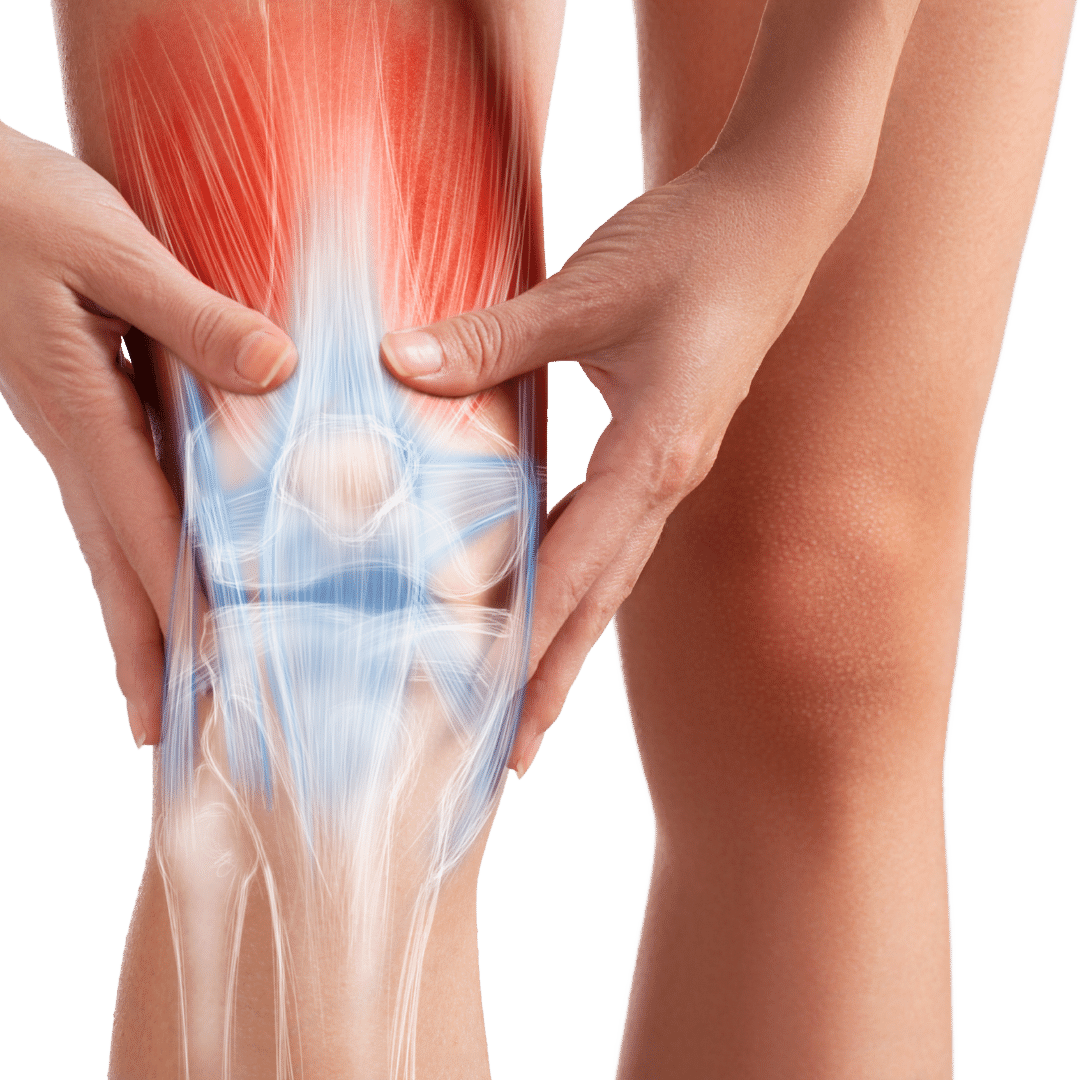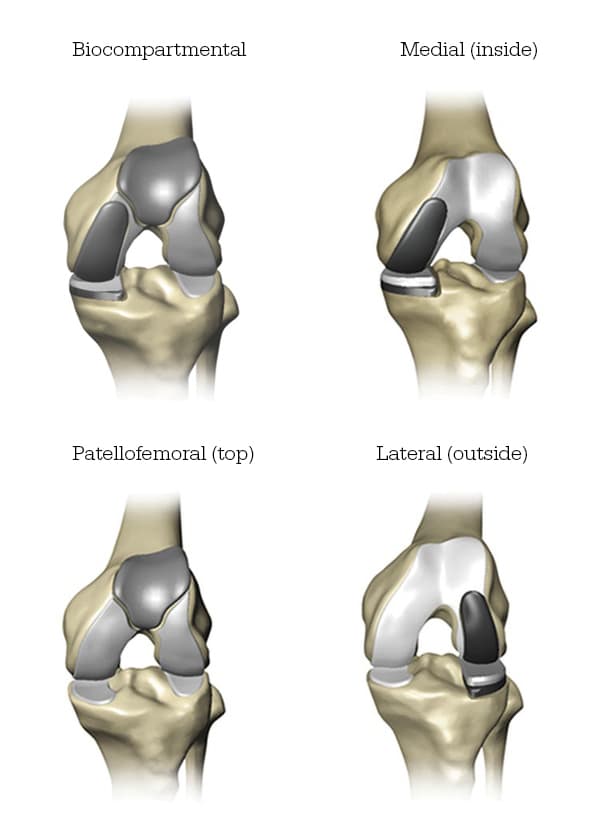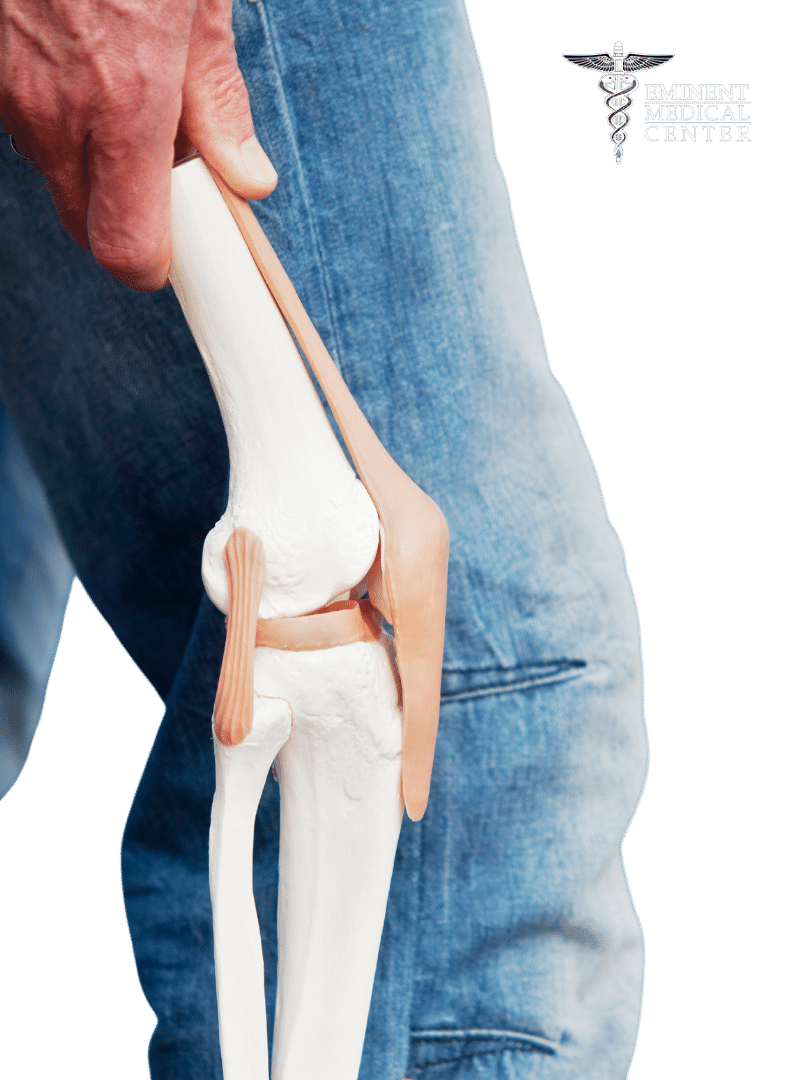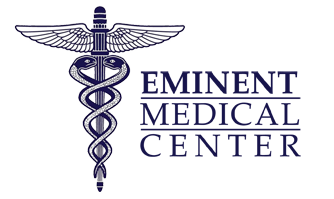Mako Partial Knee Replacement Richardson, TX

For those requiring partial knee replacement surgery, Mako Smart Robotics offers a cutting-edge option that has transformed joint replacement procedures. Partial knee replacements are among the many prosthetic joint replacement surgery options expertly conducted at Eminent Medical Center with the precision and efficiency of Mako Smart Robotics™. If you are experiencing knee pain, consider a Mako knee replacement surgery at Eminent Medical Center. Call 469-910-8800 today to begin your journey toward enhanced mobility and improved quality of life.

What is Mako Smart Robotics™?
Stryker Mako SmartRobotics™ transforms joint replacement surgeries, specifically enhancing the precision and personalization of partial knee replacements. At its core, Mako SmartRobotics™ combines three key components: 3D CT-based planning, AccuStop™ haptic technology, and insightful data analytics. This innovative system integrates advanced 3D imaging with robotic assistance, enabling the orthopedic surgeon to meticulously plan and execute knee replacements with exceptional accuracy for patients undergoing Richardson orthopedic surgery.
During knee replacement surgery, the robotic arm works alongside the orthopedic surgeon to ensure precise placement of the knee implant. The result is a more natural-feeling knee joint, quicker recovery, less pain, and improved surgical outcomes, marking Mako as a significant breakthrough in minimally invasive surgery options for joint damage.
What is a Partial Knee Joint Replacement?
Partial knee replacement, also known as unicompartmental knee replacement, is a surgical procedure designed to relieve pain and restore function to the knee joint. The unicompartmental knee arthroplasty procedure is typically recommended for most patients who have severe osteoarthritis in only one part of the knee.
When surgeons perform partial knee replacement surgeries, they remove damaged cartilage from inside and around the entire joint and replace it with plastic and metal components. This is known as “resurfacing.”
Unicondylar Knee Replacement vs Patellofemoral Knee Replacement
Patients will normally undergo one of two types of partial knee replacement: unicondylar knee arthroplasty or patellofemoral knee replacement. Unicondylar knee arthroplasty works to remove damaged cartilage from the medial compartment or the lateral compartment. Patellofemoral compartment knee replacement, which is less common, works to resurface the patellofemoral compartment and the thigh bone (femur).
Partial vs Full Knee Replacement
One of the key advantages of a partial knee replacement is its less invasive nature compared to Mako total knee replacement. Because the surgery is limited to one part of the knee, patients often experience quicker recovery times, less postoperative pain, and a better range of motion.
Another significant benefit of a partial knee replacement is the preservation of healthy bone and tissue. By focusing only on the damaged area, the procedure spares the healthy parts of the knee, which can be advantageous for future treatments or surgeries if needed.
Mako Knee Replacement vs Traditional
Mako knee replacement offers a more technologically advanced approach to partial knee replacement compared to traditional knee replacement surgery. Using Mako Smart Robotics, an orthopedic surgeon can achieve a higher level of precision, allowing for more accurate placement of knee joint implants using the patient’s anatomy. Most knee replacements traditionally, while effective, lack this customization and precision, relying on a standard surgical technique that can vary in outcomes and recovery times.
Who is a Good Candidate for a Partial Knee Replacement?
Proper patient selection for partial knee replacement is key. Doctors may suggest a partial knee replacement or a total knee arthroplasty to those with knee osteoarthritis and/or knee pain that cannot be solved with physical therapy or prescription pain medications. Partial knee replacement surgery is best suited to those with knee arthritis pain that does not affect the entire knee joint and is limited to one compartment. Knee arthritis patients who still have some range of motion in their knee joints are also good candidates for partial knee replacements.
Everyone with knee pain is a candidate for partial knee replacement surgery. Those with inflammatory arthritis, severe pain, and a limited range of motion may be better candidates for total knee replacements instead. A total knee replacement can help ease severe knee arthritis pain and restore motion to the knee joint.
At Eminent Medical Center, we conduct comprehensive assessments, including a physical examination and imaging tests, such as magnetic resonance imaging (MRI) to ensure that the patient is a good candidate for partial knee arthroplasty.

Benefits of Undergoing a Partial Knee Replacement Surgery With Mako Smart Robotics
At Eminent Medical Center, our orthopedic surgeon team prides itself on offering state-of-the-art surgical solutions for all types of joint replacement surgery, and our use of Mako SmartRobotics for partial knee replacement and total knee replacement exemplifies this commitment. This cutting-edge technology has made Mako joint replacement surgeries more accurate, allowing patients to experience better outcomes with a decreased recovery time.
Higher Accuracy for Partial Knee Replacement
Mako Smart Robotics technology significantly enhances the accuracy of partial knee replacement surgeries. With its advanced 3D imaging and planning capabilities, the system enables the orthopedic surgeon to visualize the knee’s anatomy in great detail, allowing for the precise removal of damaged bone and careful placement of the knee joint implant during knee surgery. This high level of accuracy is crucial not only for the alignment and fit of the implant but also for preserving as much of the patient’s natural bone joint and tissue as possible.
Better Partial Knee Replacement Results
The precision of Mako SmartRobotics™ directly translates into better partial knee replacement surgery results. By allowing for more accurate placement of the knee joint implant, the system ensures that the artificial joint functions more efficiently and closely mimics the patient’s natural knee movement.
This can lead to a reduction in the wear and tear on the artificial joint implant over time, potentially extending its lifespan. Additionally, this targeted approach minimizes joint damage to surrounding healthy tissues, which is crucial for maintaining the overall integrity and strength of the knee joint post-surgery.
Better Recovery Time
Patients undergoing a partial knee replacement with Mako Smart Robotics™ typically experience an easier recovery time. The precision of the partial knee replacement often results in less post-operative pain, minimal blood loss, reduced swelling, and a quicker return to normal activities for many patients. Since the technology allows for a more conservative approach with less tissue trauma, partial knee replacement patients often have a shorter hospital stay and a faster rehabilitation process. Additionally, our Richardson pain management specialists provide excellent pain relief while our Richardson physical therapist team helps in recovery through surgh physical therapy sessions after unicompartmental knee replacement.
How Partial Knee Replacements Work With Mako Smart Robotics™
At Eminent Medical Center, patients can undergo robotic unicompartmental knee arthroplasty (partial knee replacement) through the use of Mako SmartRobotics™. This partial knee replacement procedure involves three main steps, which work together to ensure the patient receives the best possible outcome.
1
CT Scan
The partial knee replacement process begins with a high-resolution CT scan of the patient’s knee joint.
This scan is crucial as it provides a detailed 3D model of the knee structure, which allows the orthopedic surgeon to better understand the anatomy of the patient’s knee.
2
Surgical Plan
Using the 3D model generated from the CT scan, the orthopedic surgeon team at Eminent Medical Center develops a comprehensive surgical plan for partial knee replacement or total knee replacement.
This plan outlines the specific areas of the knee that require resurfacing. The Mako system allows for adjustments to be made in real time during knee surgery, ensuring accuracy and optimal implant alignment.
3
Surgical Procedure
During the surgical procedure, the Mako arm is used to assist the orthopedic surgeon in removing the damaged bone and damaged cartilage from a preplanned portion of the knee joint. Mako’s AccuStop™ technology ensures that the surgeon does not move out of this preplanned area. This surgical management facilitates more accurate placement of the knee implant, leading to a more natural knee movement post-surgery. At every stage of the partial knee replacement procedure, the Mako robotic arm is under the direct control and guidance of a skilled orthopedic surgeon. This technology simply enhances the surgeon’s expertise without replacing the critical human element of decision-making and adaptability during knee replacements.
What Happens During a Mako Unicompartmental Knee Replacement Surgery?
During a Mako unicompartmental knee replacement surgery, the process is carefully structured to utilize the precision of robotic-assisted technology for improved accuracy and patient outcomes:
Pre-Operative Planning: Begin with a CT or magnetic resonance imaging (MRI) of the patient’s knee joint. This scan is transformed into a detailed 3D model, enabling the knee replacement surgeon to create a surgical plan based on the patient’s anatomy.
Customization of the Surgical Plan: Utilizing the Mako system’s software, the knee replacement surgeon can customize the placement, size, and alignment of the knee implant.
Robotic Assistance: In the operating room, the surgeon uses the Mako robotic arm to assist in performing the surgery.
Real-Time Adjustments: The Mako system provides real-time feedback during the partial knee replacement surgery, allowing the surgeon to make immediate adjustments to the plan if necessary.
How It Works
How Mako Treats Arthritis
Unicompartmental Knee Arthroplasty Precautions
Partial knee replacement surgery or medial unicompartmental knee arthroplasty, while highly effective, carries certain risks and potential complications that patients should be aware of. These include:
Infection: Infections at the incision site are possible, while rare.
Blood Clots: Blood clots in the leg veins or lungs are potential complications. Our orthopedic surgeons may recommend blood thinners.
Nerve or Blood Vessel Damage: During partial knee replacement surgeries, there is a minimal risk of injury to nearby nerves or blood vessels.
Allergic Reactions: Some individuals may experience allergic reactions to general anesthesia, regional anesthesia, nerve blocks, or materials used in the implant.
Implant Loosening or Dislocation: Over time, prosthetic components may loosen or dislocate, necessitating revision surgery.
Persistent Pain or Stiffness: While uncommon, patients may experience persistent knee pain or stiffness after partial knee replacement surgery.
It is essential for patients to discuss these potential risks and complications with their surgeon before undergoing partial knee replacement or total knee replacement surgery to make informed decisions about their treatment.


Partial Knee Replacement Recovery at Eminent Medical Center
After undergoing a partial knee replacement or total knee replacement at Eminent Medical Center, patients can anticipate the following during their recovery:
Physical Therapy: A physical therapist will help patients improve their range of knee motion, muscle strength, and mobility during physical therapy sessions. A continuous passive motion machine may be used to begin the physical therapy.
Pain Management: Richardson, TX pain management, such as oral medications or other pain medications, will be used to relieve pain during the first few weeks of recovery.
Follow-Up Appointments: Scheduled follow-up appointments with the surgeon.
Gradual Return to Normal Activities: Most patients will gradually reintegrate into daily activities and exercises, noticing less pain quickly after partial knee replacement.
Postoperative Care: Physicians will monitor vital signs in the recovery room before the patient is moved to a hospital room. Proper wound care and measures to prevent infection will be emphasized.
Eminent Medical Center is dedicated to supporting patients throughout their recovery journey following their Richardson total joint surgery, with the goal of maximizing the benefits of total knee replacement and ensuring a smooth transition back to an active and pain-free lifestyle.
Mako Partial Knee Replacement Surgery Center in Richardson, Texas
Knee arthritis and knee pain can significantly impact your life, preventing you from being active or simply living comfortably. That’s why we at Eminent Medical Center offer partial knee replacements to the residents of Richardson, TX, and beyond. With our state-of-the-art Mako SmartRobotics™ technology and a team of experienced orthopedic surgeons, we are equipped to provide you with the best care for your partial knee replacement surgery needs.
When you choose Eminent Medical Center for your orthopedic surgery, you take a significant step towards regaining comfort and mobility. Our dedicated staff is committed to guiding you through every step of the process – from your initial consultation to pain management to your partial knee replacement recovery period – ensuring you receive the support you need.
Don’t let knee pain limit your lifestyle any longer. Call us at 469-910-8800 or contact us online to schedule an appointment with us regarding your partial knee replacement.

Important Information
Knee replacement is intended for use in individuals with joint disease resulting from degenerative and rheumatoid arthritis, or avascular necrosis.
Knee joint replacement is intended for use in individuals with joint disease resulting from degenerative, rheumatoid and post- traumatic arthritis, and for moderate deformity of the knee.
Joint replacement surgery is not appropriate for patients with certain types of infections, any mental or neuromuscular disorder which would create an unacceptable risk of prosthesis instability, prosthesis fixation failure or complications in postoperative care, compromised bone stock, skeletal immaturity, severe instability of the joint, or excessive body weight.
Like any surgery, joint replacement surgery has serious risks which include, but are not limited to, pain, infection, bone fracture, change in the treated leg length (hip), joint stiffness, hip joint fusion, amputation, peripheral neuropathies (nerve damage), circulatory compromise (including deep vein thrombosis (blood clots in the legs)), genitourinary disorders (including kidney failure), gastrointestinal disorders (including paralytic ileus (loss of intestinal digestive movement)), vascular disorders (including thrombus (blood clots), blood loss, or changes in blood pressure or heart rhythm), bronchopulmonary disorders (including emboli, stroke or pneumonia), heart attack, and death.
Implant related risks which may lead to a revision of the implant include dislocation, loosening, fracture, nerve damage, heterotopic bone formation (abnormal bone growth in tissue), wear of the implant, metal and/or foreign body sensitivity, soft tissue imbalance, osteolysis (localized progressive bone loss), audible sounds during motion, reaction to particle debris , and reaction to metal ions (ALTR). Hip and knee implants may not provide the same feel or performance characteristics experienced with a normal healthy joint.
The information presented is for educational purposes only. Speak to your doctor to decide if joint replacement surgery is appropriate for you. Individual results vary and not all patients will return to the same activity level. The lifetime of any joint replacement is limited and depends on several factors like patient weight and activity level. Your doctor will counsel you about strategies to potentially prolong the lifetime of the device, including avoiding high-impact activities, such as running, as well as maintaining a healthy weight. It is important to closely follow your doctor’s instructions regarding post-surgery activity, treatment and follow-up care. Ask your doctor if a joint replacement is right for you.
Stryker Corporation or its other divisions or other corporate affiliated entities own, use or have applied for the following trademarks or service marks: AccuStop, Mako, Stryker, Triathlon. All other trademarks are trademarks of their respective owners.
References
- Kayani B, Konan S, Tahmassebi J, Rowan F, Haddad F. An assessment of early functional rehabilitation and hospital discharge in conventional versus robotic-arm assisted unicompartmental knee arthroplasty: A PROSPECTIVE COHORT STUDY Bone Joint J 2019;101-B:24–33
JR-MKOSYM-OTHW-747688
Copyright © 2023 Stryker





